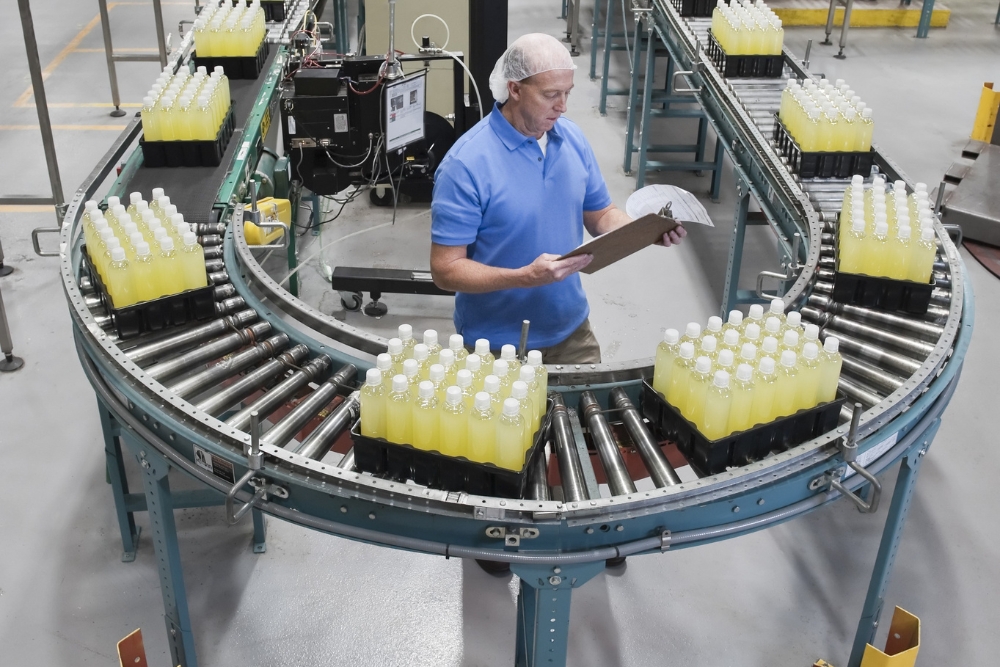7 Key Considerations for Coatings in Food and Beverage Facilities
Food and beverage processing facilities operate in some of the most demanding environments, where safety, hygiene, and durability are non-negotiable. High-performance coatings play a critical role in protecting floors, walls, and equipment surfaces, ensuring compliance with strict industry regulations while enhancing operational efficiency. Whether you’re planning a new facility or upgrading an existing one, here are seven essential considerations when selecting and applying coatings in a food and beverage environment.

1. Engaging Coatings Experts Early in Line Expansions
When expanding production lines or upgrading facilities, involving coatings experts from the start can prevent costly rework and ensure that surfaces are designed for long-term performance. Coatings professionals help facility teams assess environmental conditions, regulatory requirements, and durability needs to specify the right materials for each area. Early collaboration also streamlines project timelines, minimizing disruptions to ongoing operations and ensuring seamless integration with existing infrastructure.
2. Meeting Strict Regulatory Standards
Stricter regulations and increased consumer scrutiny leave no room for error. Coatings used in food and beverage facilities must comply with rigorous safety and hygiene standards set by federal and local regulations and agencies. Choosing coatings that resist microbial growth and are easy to clean helps facilities maintain compliance while ensuring consumer safety. Additionally, coatings in food contact areas or high-moisture environments must meet certification requirements to avoid compliance failures, fines, or operational disruptions.
3. Withstanding Harsh Facility Conditions
Surfaces in food and beverage processing environments endure high-pressure washdowns, heavy equipment traffic, and fluctuating temperatures. Coatings must provide strong resistance to moisture, impact, and chemical exposure to prevent degradation over time. Without the right coatings, floors and walls can crack, peel, or wear down, increasing contamination risks and safety concerns. Durable coatings reduce the need for frequent repairs, helping facilities maintain operational efficiency and minimize long-term maintenance costs.
4. Prioritizing Hygiene and Cleanability
Bacteria, mold, and other contaminants pose a threat in food processing areas. Seamless, non-porous coatings create easy-to-clean surfaces that prevent microbial growth and support strict sanitation protocols. Some coatings also incorporate properties that actively inhibit bacteria, further reducing contamination risks. Proper application and routine maintenance enhance the effectiveness of these coatings, ensuring they provide long-term protection.
5. Reducing Downtime with Proactive Site Surveys and Maintenance
Minimizing downtime is critical in food production, making rapid-curing coatings a valuable option for facilities looking to complete installations or repairs with minimal disruption. A proactive maintenance strategy—starting with regular site surveys—helps facilities identify problem areas before they lead to failures. Coatings experts can conduct assessments to check for early signs of wear, such as cracking or peeling, allowing teams to plan targeted reapplications in high-traffic areas. Visual inspections ensure that coatings remain effective, reducing unexpected shutdowns and repair costs.
6. Prioritizing Worker Safety
Ensuring employee safety is paramount when selecting coatings for food and beverage facilities. Slip-resistant and nonskid flooring options are essential to prevent accidents, particularly in areas where spills and moisture are common. These coatings provide a stable surface that reduces the risk of slips and falls, enhancing worker safety in high-traffic zones. Additionally, thermal insulative coatings (TICs) offer significant protection against heat, safeguarding employees who work near ovens, stoves, or pipes. TICs help maintain external equipment temperatures below the Occupational Health and Safety Administration’s (OSHA) 140°F skin-contact limit, minimizing burn injuries and preventing condensation buildup that can lead to slippery floors. By incorporating these specialized coatings, facilities can create a safer work environment that mitigates hazards and promotes overall well-being.
7. Addressing Facility Needs Across Its Lifecycle
Coatings must support the entire facility lifecycle, from initial construction to ongoing maintenance and future renovations. Different areas within a facility—such as processing lines, storage rooms, loading docks, and washdown zones—have unique coating requirements. By selecting coatings tailored to each environment, facilities managers can enhance performance, safety, and longevity across all surfaces. Long-term planning for reapplications ensures that facilities remain in peak condition, reducing the risk of compliance issues or costly overhauls.
A Proactive Approach to Facility Coatings
Strategic coating selection and maintenance are essential for food and beverage facilities to operate efficiently while meeting industry standards. Engaging coatings experts early in facility projects and conducting regular site surveys ensures that surfaces remain durable, hygienic, and compliant. By prioritizing compliance, durability and long-term facilities management, facility owners and managers can create safer, more resilient environments that protect both workers and consumers.
Investing in the right coatings today helps facilities maintain food safety, regulatory compliance, and operational efficiency—ensuring reliability in every stage of production, and inspiring confidence in every sip and bite produced.

Feraas Alameh is the food and beverage market segment manager for Sherwin-Williams Protective & Marine. He is a seasoned business professional with nearly 15 years of experience in the coatings industry, leading various market segments with an emphasis on front-end innovation and business and market strategy. He earned his bachelor’s degree from Cleveland State University and has completed continuing education programs at the Weatherhead School of Management at Case Western Reserve University and the Fisher College of Business at Ohio State University.
ALSO READ: How Solar Can Optimize Costs and Sustainability for Food and Beverage Facilities
The post 7 Key Considerations for Coatings in Food and Beverage Facilities appeared first on Facilities Management Advisor.

